Arizona Is the Frequent Super Bowl Host that has Never Been the Super Bowl Parade Host
- Ken Smoller
- Feb 4, 2023
- 11 min read
Updated: Apr 16, 2023


Downtown Phoenix in 2022, with the Arizona Diamondback’s Chase Field (formerly Bank One Ballpark) visible on the left side.
Arizona is not like any of the other forty-nine United States. It has a unique topography that ranges from deep canyons, snowcapped mountains, cacti-filed deserts and traffic-ladened cities. While its capital city of Phoenix is a booming megalopolis, it is not quite like other growing US cities. For example, American homeowners may obsess over their lawns and back yard landscaping, the Valley of the Sun is devoid of the greenery that characterizes suburbia. It’s also a region that has largely developed after the invention of the automobile, so it lacks a compact infrastructure compared with older US cities.
Another distinction is its people. Only perhaps surpassed by Florida, Arizona is filled with hyphenated citizens such as Scottsdale-Chicagoans or Tucson-Texans. With all those “expats” moving to the Grand Canyon state, it gives sporting events a decidedly neutral site feel. It’s not uncommon to witness a Arizona Cardinals quarterback struggle with the deafening howls of Chicago Bears fans at State Farm Stadium. Similarly, a goal by the LA Kings against the Coyotes yields a raucous cheer from Californian carpetbaggers.
Given this unusual hybrid sports terrain, it is almost fitting that for a state that has frequently hosted championship events, it barely has a championship pedigree of its own. This year, Arizona may be hosting Super Bowl LVII, but does not have any Lombardi trophies residing in local trophy cases.
Clockwise from top left: Downtown Phoenix as viewed from a plane arriving at Sky Harbor Airport; the sun setting over downtown Phoenix; Tall cacti with Camelback Mountain the background; State Farm Stadium (formerly University of Phoenix Stadium) – home of Super Bowl LVII; The Los Angeles Kings scoring against the hometown Arizona Coyotes.
The story of Arizona’s NFL history actually did not begin in Arizona. Like many Arizonans, the Cardinals’ origins are in Chicago. The team originally started as the Morgan Athletic Club in 1898 on the South Side of Chicago and are “the oldest continuously running professional football team in the United States“. They were renamed the Racine Cardinals because they played at 61st and Racine Street and wore used University of Chicago maroon uniforms. The Racine Cardinals are of one of two still-existing charter members of the National Football League along with their old neighborhood rivals the Chicago Bears (originally, the Decatur Staleys).
During their Chicago years of 1920-1959, the renamed Chicago Cardinals primarily shared Comiskey Park with the White Sox, but also had stints at Wrigley Field and Soldier Field. In those days, many Chicagoans were either Bears/Cub fans or Sox/Cardinals fans (well, at least according to my dad). While the Arizona Cardinals have never won the Super Bowl, the Chicago Cardinals won the NFL Championship twice in 1925 and 1947. In 1960, the Cards abandoned Chicago and became the St. Louis Football Cardinals to avoid a naming conflict with their better known St. Louis baseball bird brethren. During their largely forgettable 27 years in St. Louis, the Cardinals mainly played at the Busch Memorial Stadium after starting their St. Louis residency at the baseball Cardinals’ home Sportsmen’s Park. The St. Louis Football Cardinals only made the NFL playoffs three times, never winning a postseason contest.
Clockwise from Top Left: Comiskey Park, the Cardinals’ home for most of their Chicago games; Wrigley Field, the Cardinals’ home during the 1930s; Soldier Field, the Cardinals’ part-time home during their last year in Chicago in 1959 (the team also played 2 games that year at Metropolitan Stadium in Bloomington, MN); Busch Memorial Stadium during a 1993 Cards baseball game and as viewed from the St. Louis Arch.
In 1988, the Cardinals’ owner, Bill Bidwell, relocated the team from the Gateway City to suburban Tempe, Arizona. Again, the Phoenix Cardinals would be the interloping roommate, this time for eighteen years with the Arizona State University Sun Devils at their on-campus Sun Devil Stadium. Like a lot of college roommates crashing on Tempe couches, the Cardinals never amounted to much during that era. Sun Devil Stadium did have the honor of hosting the 1996 Super Bowl between Dallas Cowboys and Pittsburgh Steelers. While not quite a Cards’ Super Bowl victory, but a few “Bird Gang” players probably snagged some tickets for the big game.
Sun Devil Stadium in 2022, the current home of the Arizona State University Sun Devils and former home of the then-named Phoenix Cardinals.
The Cardinals belatedly grew up and flew the coop to their very own home in the futuristic University of Phoenix (the old corporate name) Stadium in 2006. The UOP Stadium is 22 miles west in deeply suburban Glendale and 14 miles from downtown Phoenix. Not surprisngly, given the overabundence of dry heat rising from the Arizona desert, the stadium has a retractable roof that opens and closes in mere minutes. More unusually, the UOP also has a retractible grass field that grows outside and is transported by an elaborate 546 steel wheel system.
While the renamed Arizona Cardinals have found more success since the move, they still lack a Super Bowl trophy. The team’s only whiff of the Lombardi Trophy was their Super Bowl XLIII 2009 loss to the Pittsburgh Steelers in at Raymond James Statdium in Tampa, FLA. It is likely cold comfort (no weather pun intended) to the members of the “Bird Gang“, their current homefield has hosted the Super Bowl twice – Super Bowl XLII in 2008 between the New York Giants and New England Patriots and Super Bowl XLIX in 2015 between the New England Patriots and Seattle Seahawks.
Clockwise from top left: University of Phoenix Stadium under construction in 2004; WrestleMania XXVI in 2006; the retractable grass turf system baking under the Arizona sun; the unique facade of the Cardinal’s new home; a panoramic view of the stadium at WrestleMania XXVI.
State Farm Stadium also has hosted the college football championship three times in 2007, 2011 & 2016 and the men’s NCAA Final Four in 2017 (returning again in 2024). In addition to those real sports championships, a number of championship belts were handed out at Wrestlemania XXVI in 2010 in front of 72,219 WWE fans.
Scenes from WrestleMania XXVI at the University of Phoenix Stadium in 2010.
Shortly before the construction of the Cardinal’s new nest, the Arizona Coyotes hockey team set up shop in Glendale in 2003. The NHL team’s first Arizona home was the Phoenix Suns’ downtown arena (known by so many names, that it will likely change before you read this sentence). Given that the Suns’ arena was built for basketball, and could not quite accommodate a full-size NHL rink without many fan blind spots, the Coyotes moved to the new 18,300 seat arena down the street from UOP Stadium (also known by too many names to bother mentioning).
The move did not yield success. Similar to the mercurial fanbases of other area sports teams, the support of the Coyotes “faithful” has been anemic at best. After years of underwhelming crowds at its many-named Glendale arena, the “Yotes” recently relocated to a temporary home in the new 4,600 seat Mullett Arena on the ASU campus in Tempe. They are hoping for a fresh start in a new Tempe arena that is up for voter approval in May 2023. The plan is for the development a 16,000 seat arena (sure to be known by many names), a 3,500 seat theater, housing and two hotels.
Top Left: A 2022 Coyotes game at Gila River Arena before a sparse crowd; Top Right: Mullett Arena on ASU’s campus, which will be the Coyotes’ temporary home despite being less than 5,000 capacity; Bottom: The sun setting over central Phoenix.
But I digress…The Coyotes originally were the beloved Winnipeg Jets, who played in an aging arena next to the now-demolished CFL’s Winnipeg Blue Bomber’s Canad Inns Stadium. Given that its rabid fanbase was relatively small, the Jets finally succumbed to the south blowing economic winds and sought a relocation. It first searched for a south of the border home by unsuccessfully flirting with nearby Minnesota and the Timberwolves’ Target Center. The Manitoba hockey team ultimately changed countries and identities in 1996 when it moved to Arizona. During its time without an NHL team, diehard Winnipeggers got their hockey methadone with the AHL minor league Manitoba Moose playing in a brand new downtown arena. Like the Coyote’s Glendale home, the arena was constructed in 2003 and also has been known by multiple corporate overlord names. Winnipeg’s NHL starved fanbase got their fix by luring the under loved Atlanta Thrasher hockey team in 2011 and brought back the Jets moniker. While the Coyotes struggle to attract ticket buyers in Arizona, the Winnipeg Jets 2.0 got the last laugh and regularly sell out games in the “Peg”. Advantage Winnipeg. |
Clockwise from Top Left: Canad Inns Stadium (demolished 2013), former home of the Winnipeg Blue Bombers and original neighbor of the Winnipeg Jets 1.0; The current home of Winnipeg Jets 2.0, the Canada Life Centre; Downtown Winnipeg; State Farm Arena in Atlanta, Georgia – the Atlanta Thrashers home before they moved to Winnipeg; The Target Center, home of the Minnesota Timberwolves and WNBA Lynx and almost home of the Coyotes.
It’s not entirely surprising that the Arizona Cardinals lack a hardcore fan base urging on their team to the Super Bowl given the state’s long association with exhibition sports. Specifically, the Cactus League has been hosting preseason Spring Training games since 1947. Today, there are ten spring training facilities, hosting fifteen major league baseball teams. The closest spring training site to State Farm Stadium is Camelback Ranch, home to the Los Angeles Dodgers and Chicago White Sox spring training operations since 2009. State Farm Stadium can even be seen on the horizon of the third base line at the 13,000 seat main ballpark.
Camelback Ranch in Glendale, Arizona near State Farm Stadium, spring home of the Chicago White Sox and Los Angeles Dodgers.
Whether one comes to Arizona for Cardinals football, the Super Bowl, Spring Training or the Final Four, it is worth exploring all of the corners of this unique state. Its northeast corner is particularly unusual as it borders three other states and is home to a one of a kind roadside attraction. The Four Corners monument marks the spot where Utah, Colorado, New Mexico and Arizona meet. Besides being a region of stunning scenery, the Navajo Nation-administered attraction has a daily market of Native American craft vendors.
The Four Corners region is otherworldly beautiful and also is home to one of the quirkiest roadside attractions in the United States.
About halfway between the Four Corners region and State Farm Stadium is the beautiful ski and college town of Flagstaff. The “Staff” is the opposite of Phoenix, with its scenic mountains and snowy winters. The quirky city is a pleasant escape from the desert heat of Southern Arizona.
Flagstaff, Arizona has a funky downtown filled with bars and restaurants. Its higher elevation leads to snowy winters.
State Farm Stadium is not the first football dome in the state of Arizona. Long before Arizona had an NFL team challenging for Super Bowls, the Northern Arizona University Lumberjacks played on their Flagstaff campus in the J. Lawrence Skydome since 1977. The dome also houses the NAU men’s and women’s basketball teams. The stadium is 6,880 feet above sea level and was once was the world’s largest wooden structure of its kind.
The J. Lawrence Skydome in Flagstaff has been the home of Northern Arizona University’s football and basketball teams since 1977.
On the road between Flagstaff and the Phoenix area is the captivating Montezuma Castle National Monument. Just a few minutes off the interstate is the well-preserved dwelling complex built by the Sinagua people about a thousand years ago. Be sure to check the weather before you leave the Phoenix area as it can be dramatically colder as you drive north to the higher elevations.
About an 90 minutes from Phoenix, Montezuma Castle National Monument has thousand year old ruins from the Sinagua people.
Above 2 hours south of State Farm Stadium is the storied Arizona Stadium, home of the University of Arizona Wildcats football team since 1929. Although the Wildcats similarly lack a championship pedigree, they have rich history dating back to their first season in 1899. Beyond U of A’s campus, Tucson is diverse city with loads of worthwhile attractions.
Left: Arizona Stadium in Tucson, longtime home of the University of Arizona Wildcats; Middle & Right: Downtown Tucson.
One of the most memorable Tucson area sites is Saguaro National Park. The park is home countless saguaro cacti piercing the sky. An Arizona-speak insider tip from my Aunt Barbara – the “g” is silent. Regardless of your pronunciation, you can visit the park on either the east or west side of Tucson.
Saguaro National Park is split between two distinct areas on both the east and west sides of Tucson.
Back in Phoenix, sports fans fan visit a different type of historic site. Arizona Veteran’s Memorial Coliseum opened back in 1965 on the State Fairgrounds. The classic old arena most famously was the home to the NBA Phoenix Suns from their founding in 1968 until they moved to the new America West Arena downtown in 1992. The time capsule of an arena is still used for high school basketball and other events.
Left: Arizona Veteran’s Memorial Coliseum was the home of the Phoenix Suns from 1968-1992. Right: The Sun’s downtown Phoenix arena since 1992, which was the Phoenix Coyote’s home for seven years.
While Arizona’s Cardinals, Coyotes and Suns are all still in thirsting for their first championships, the expansion Arizona Diamondbacks did win a thrilling World Series title in 2001 over the New York Yankees. Besides being the first major league ballpark to include a pool overlooking the playing field, Bank One Ballpark (now Chase Field) was the site of one of the best World Series games in baseball history. With the Yankees leading in the bottom of the 9th inning of the seventh game, the Dbacks staged a comeback against Hall of Fame closer Mariano Rivera for possibly the worst blown save ever. After tying the game, Arizona would win its first major professional championship on a bases loaded hit by Luis Gonzalez.
Fun Side note: Rivera would go on to blow two saves in the 2004 ALCS in an epic comeback Boston Red Sox pennant victory.
Chase Field (formerly Bank One Ballpark) has a retractable roof, swimming pool and small museum featuring artefacts from their dramatic 2001 World Series victory over Mariano River and the New York Yankees. Bottom Right: Mariano Rivera being ironically cheered by Red Sox fans at their 2005 Opening Day championship flag raising and ring ceremony at Fenway Park in Boston.
While Cardinal fans still await their first Super Bowl championship, there have been pro football titles in Arizona. The arena football Arizona Rattlers have won SIX championships in their history since their founding in 1992. The Rattlers have played most of their games at the downtown stadium now known as the Footprint Center (formerly, America West Arena, US Airways Center, Talking Stick Resort Arena, PHX Arena and Phoenix Suns Arena). The “Purple Palace” has housed many teams, but is best known as the home of the NBA’s Phoenix Suns and the WNBA’s Phoenix Mercury (3x champs, thank you very much).
Arizona can be a disorienting place. A staggering number of its citizens come from elsewhere, leading to an overall amorphous personality. Its sports fans tend to be a bit fair weather and focused more on their native team allegiances. Arizona is a state that has every kind of climate, but its largest city is best known for its crippling hot summer weather. The Valley of the Sun hosts a lot of confetti canon infused trophy celebrations, but almost none for its hometown teams. The championship drought is a shame because downtown Phoenix would look pretty surreal with some sort of desert themed championship parade.
Clockwise from top left: Sunset over Camelback Mountain in Paradise Valley; a mural in the Roosevelt Row art district; Prince mural near downtown Phoenix; a Cacti-filled vista in the Valley of the Sun; the Valley Metro Streetcar on Central Avenue north of downtown Phoenix.
All photographs and text by Ken Smoller. ©2023 Stadium Vagabond – All Rights Reserved.



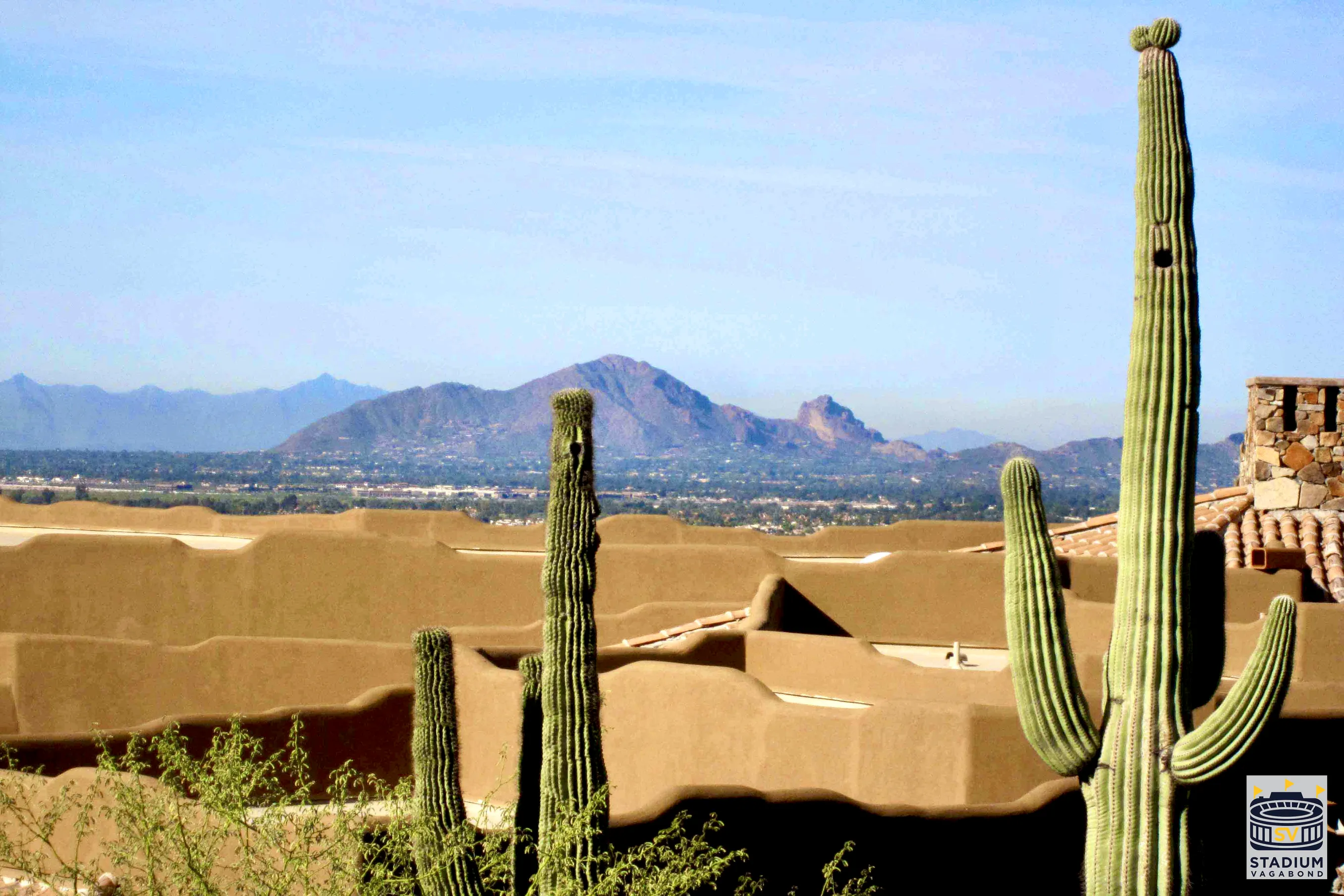
























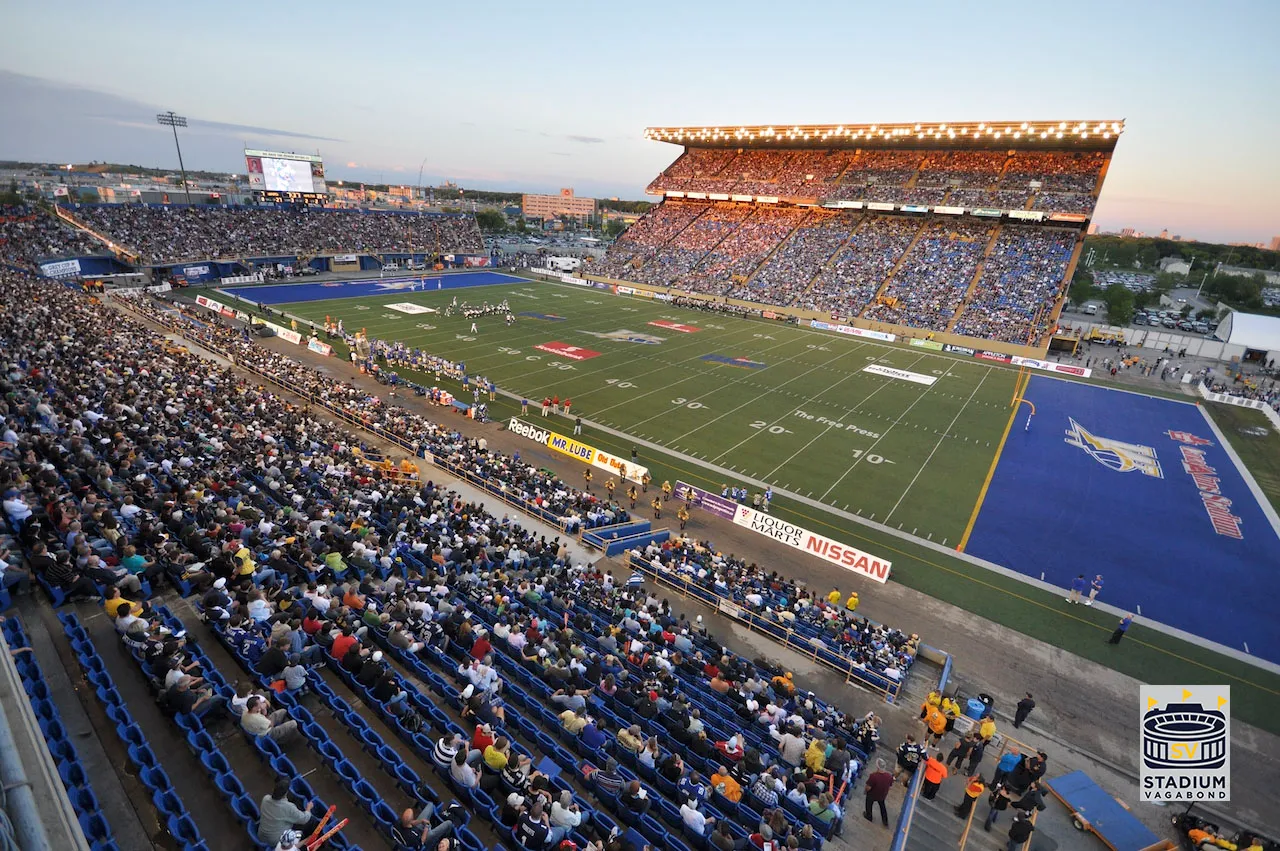




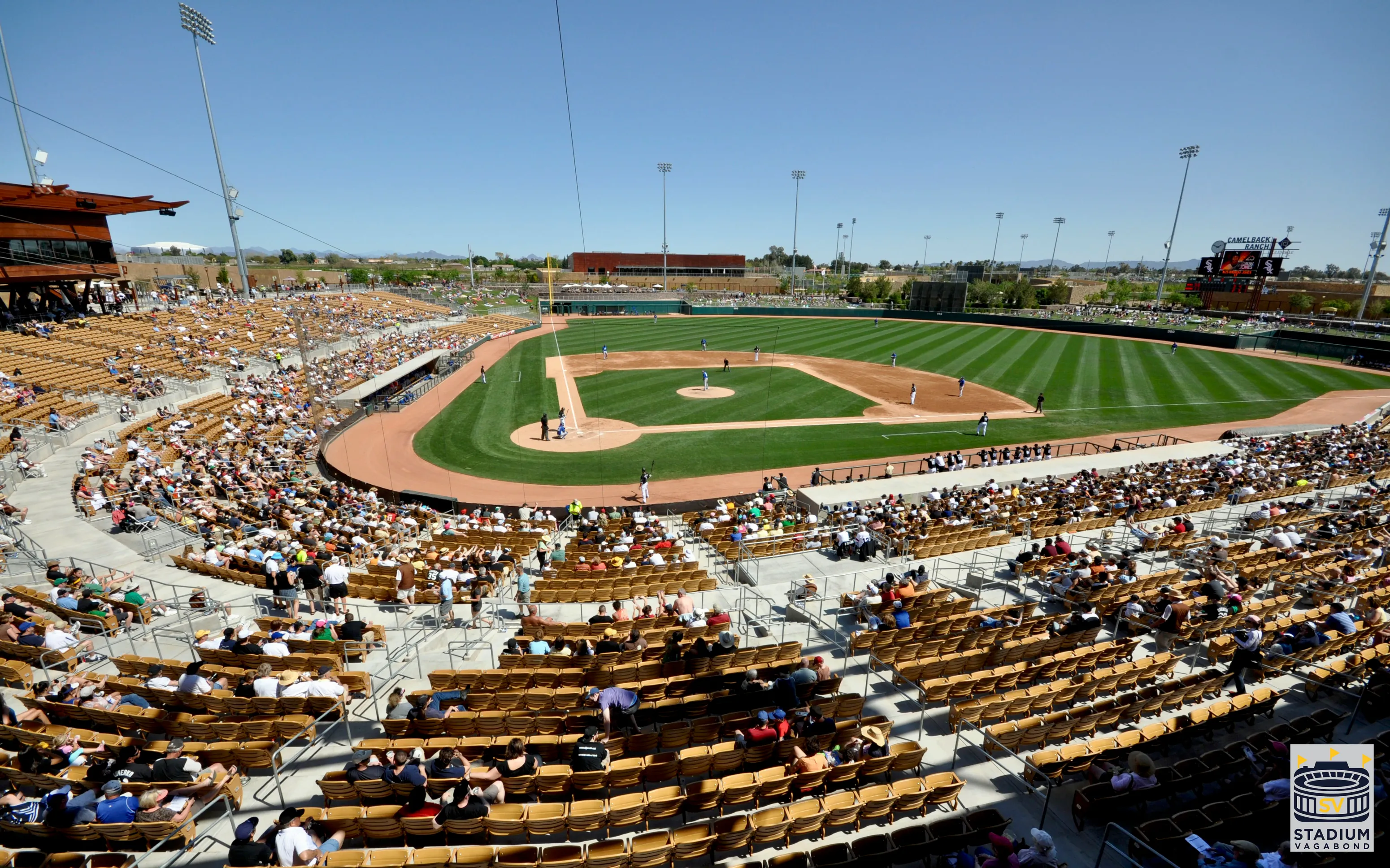





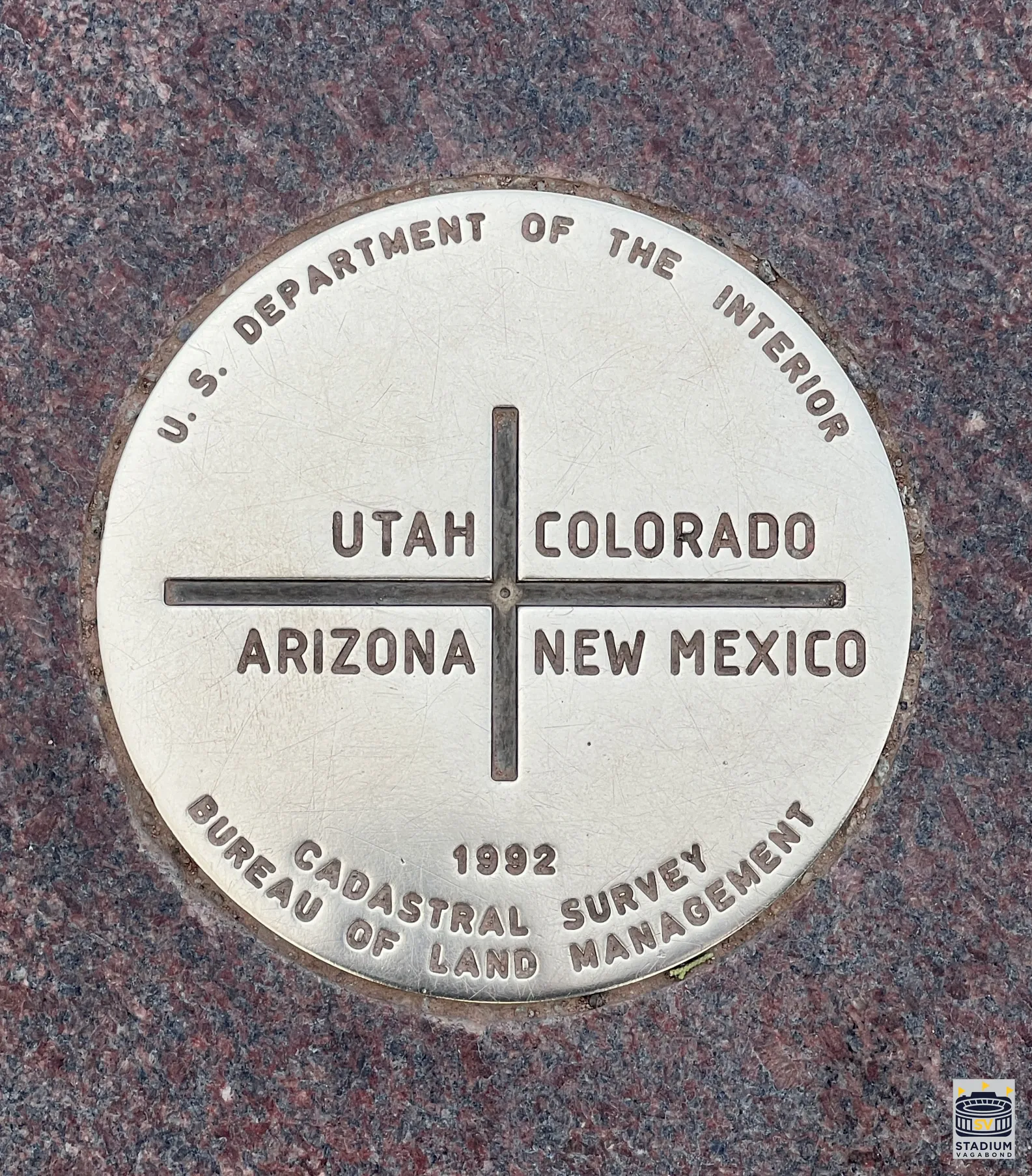





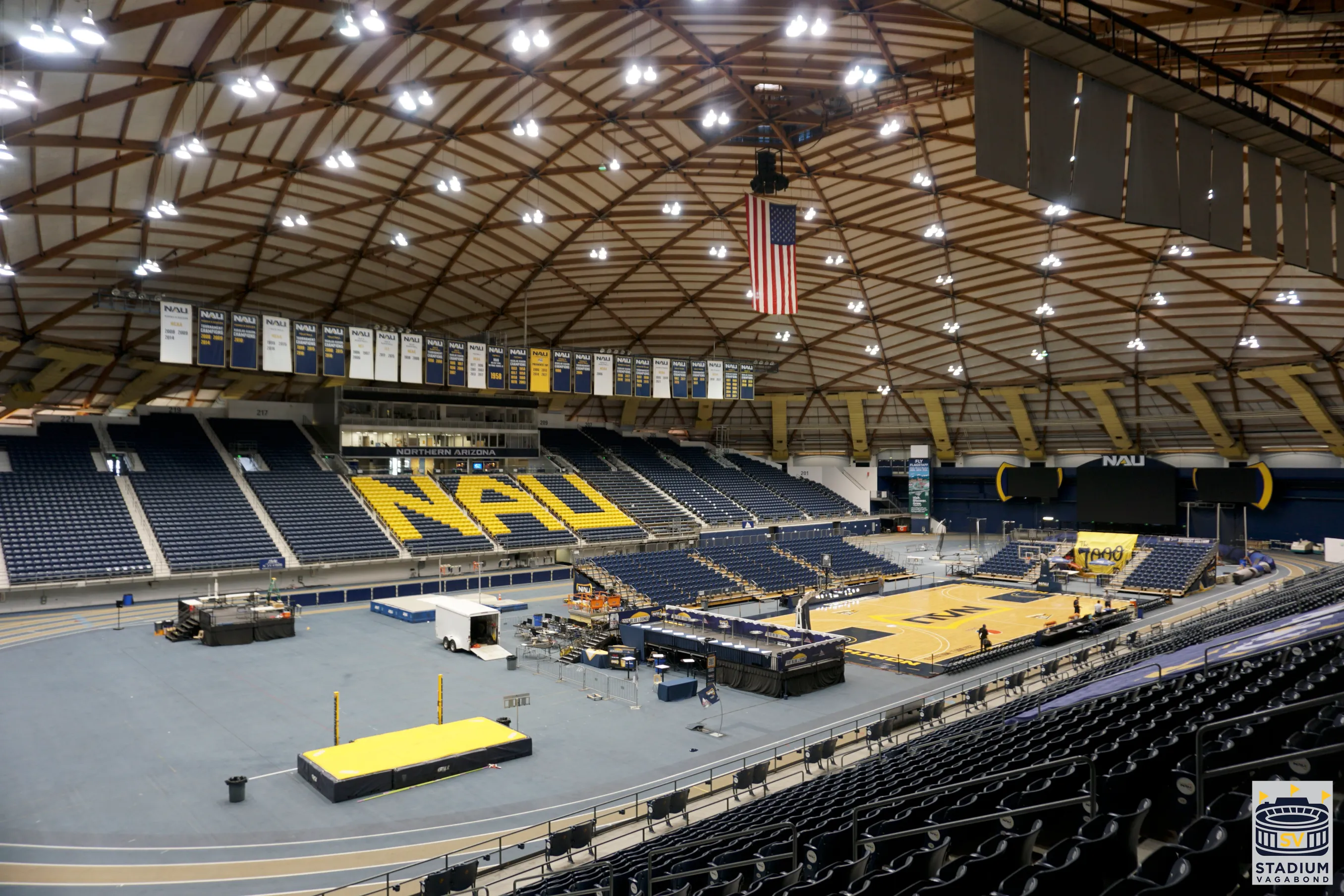














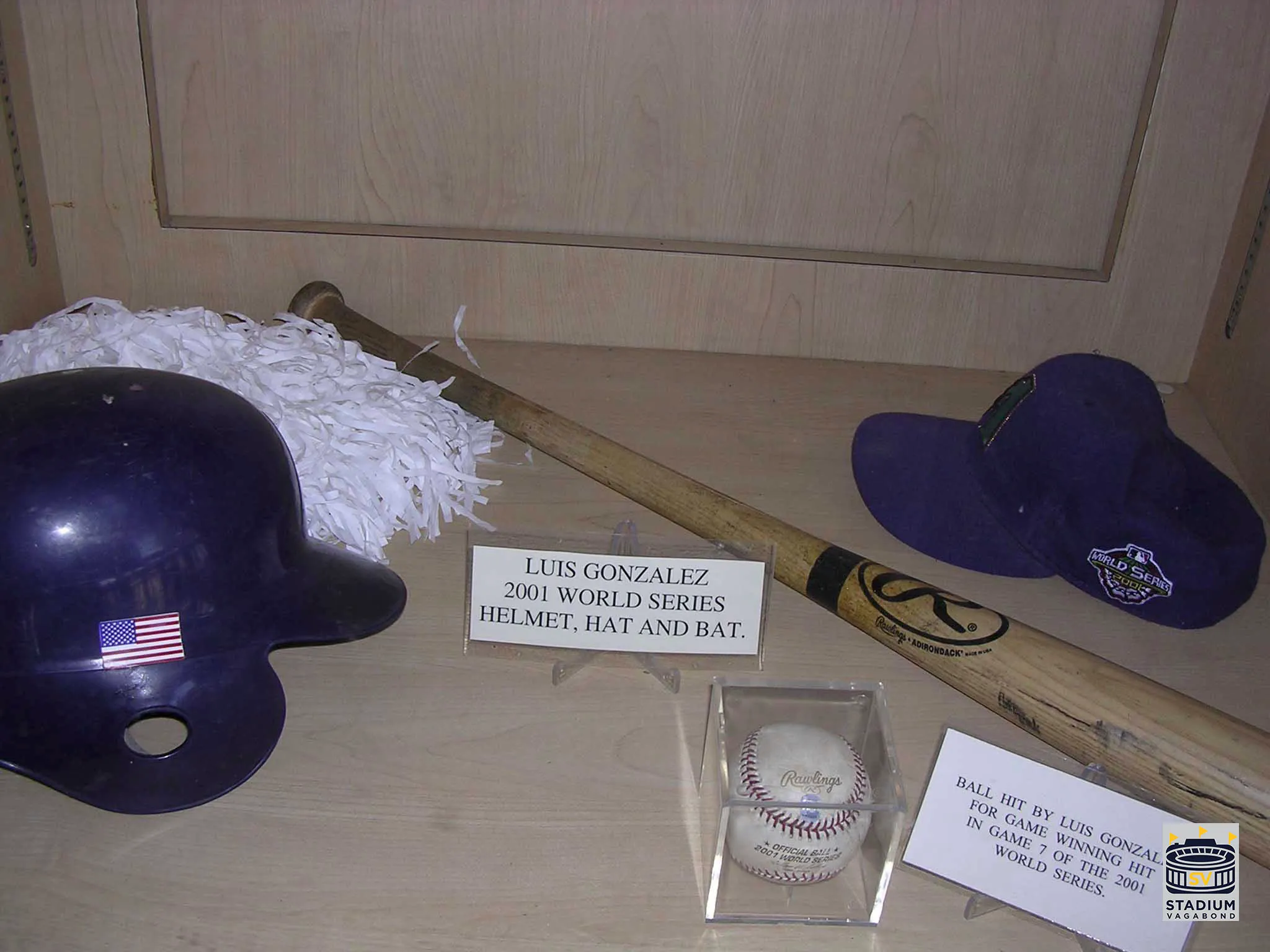




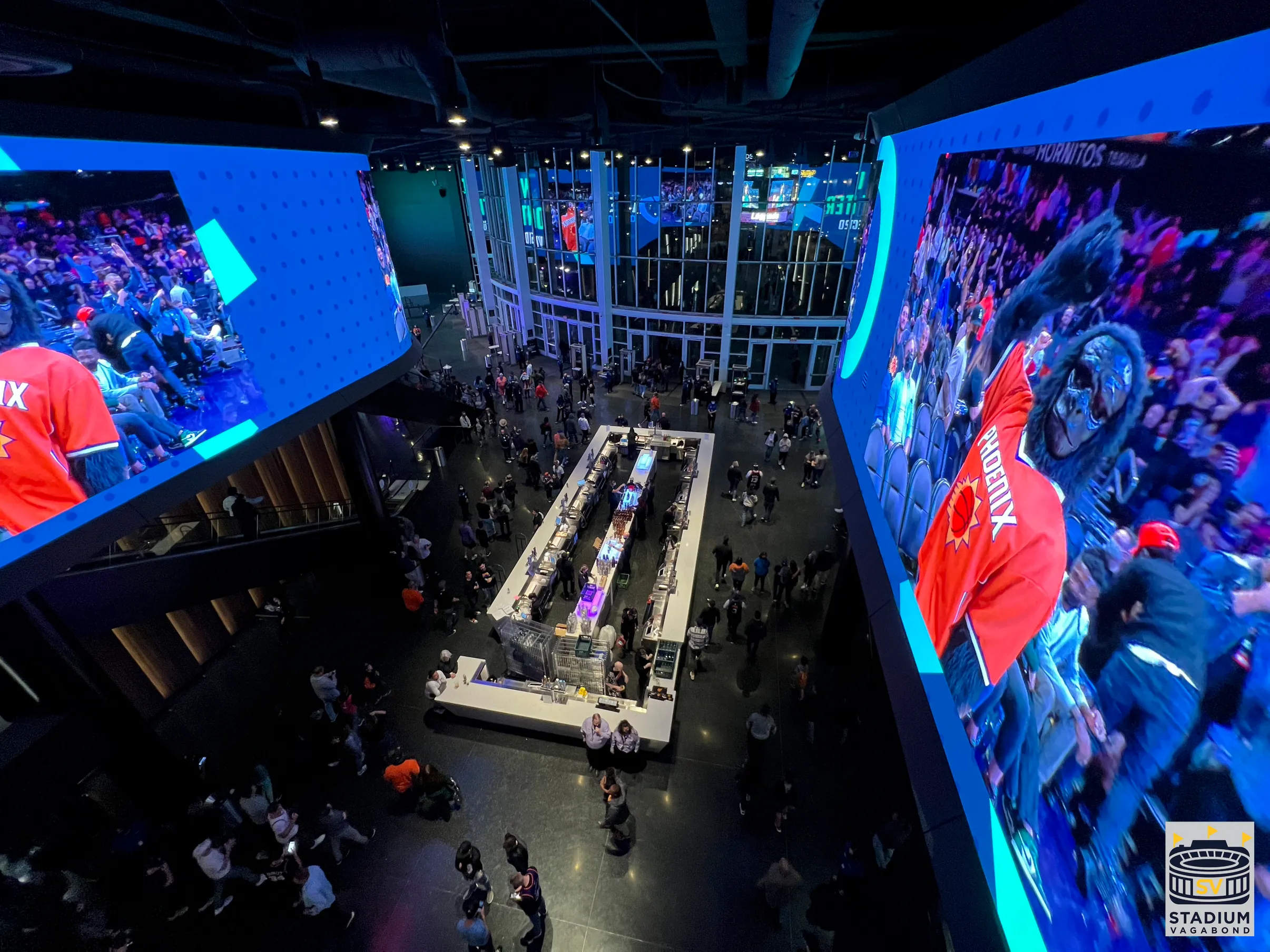

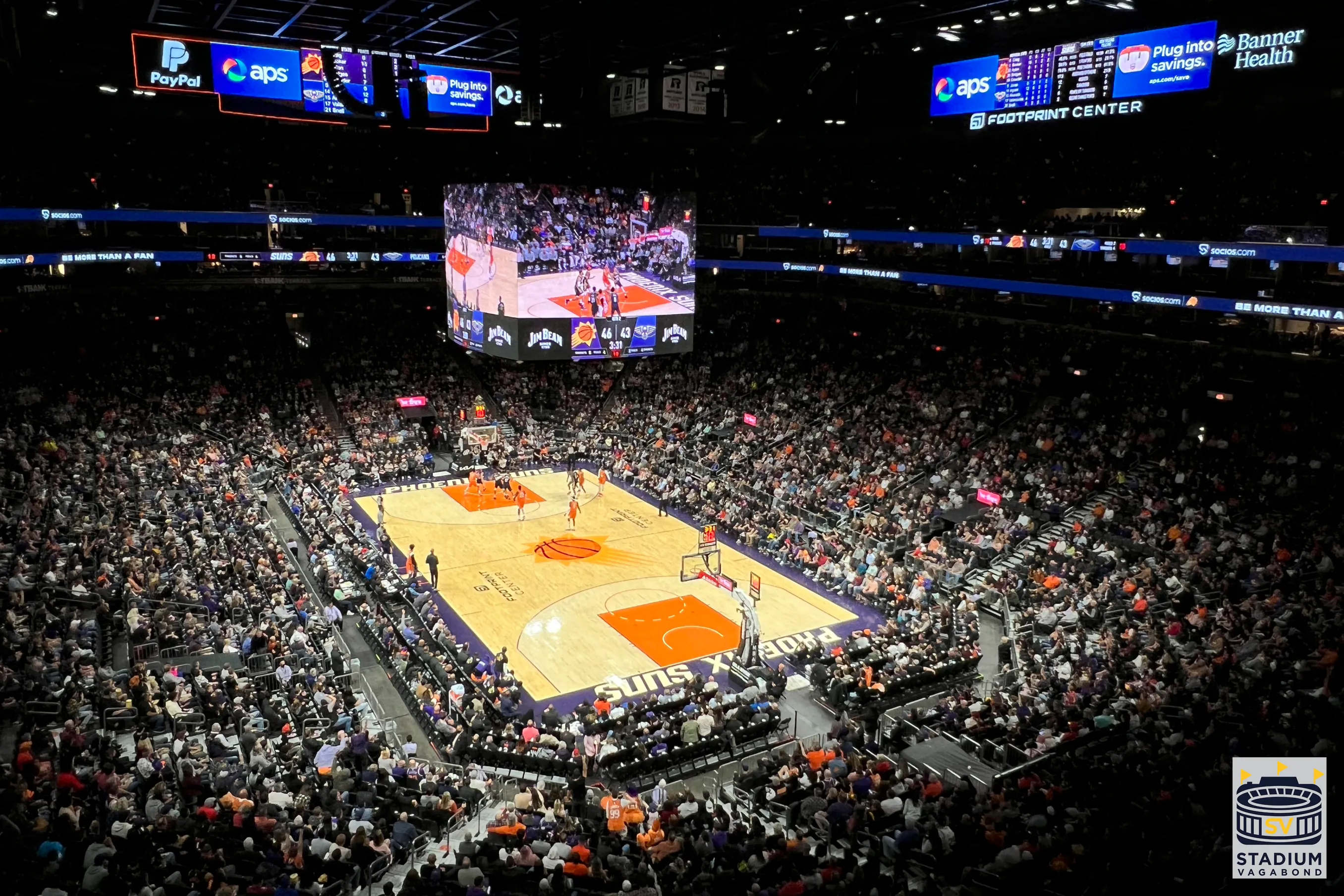






Comments